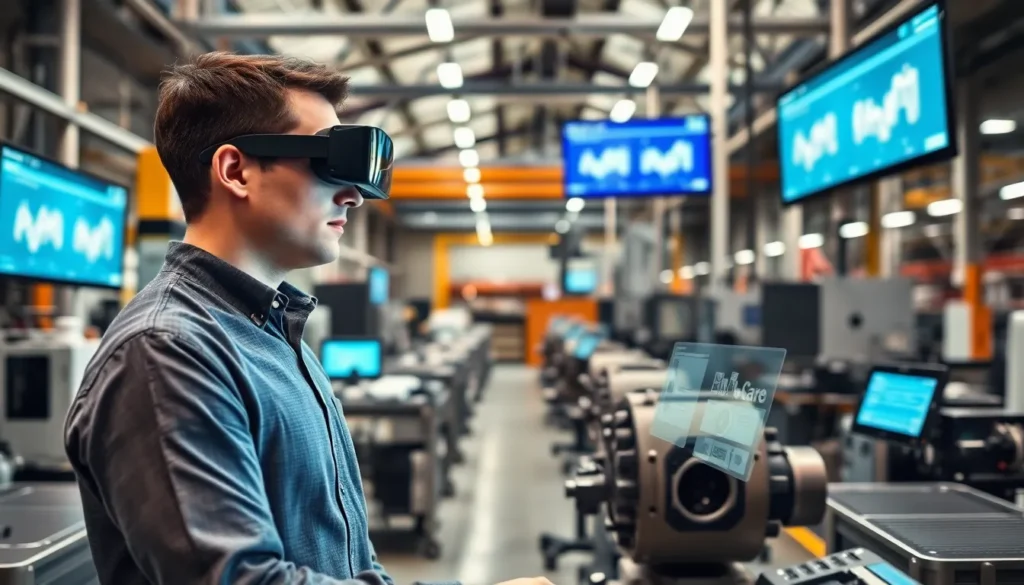Imagine walking through a mall and seeing holograms showing you discounts on your favorite shoes or being able to see how that new sofa would look in your living room without lifting a finger. Welcome to the world of augmented reality (AR). This fascinating technology overlays digital information and images onto the real world, and while it might sound like something out of a sci-fi movie, it’s truly reshaping the way we experience our environment. If you’re curious about what augmented reality is, how it works, and why it’s set to become an integral part of our lives, keep reading. Not only is this technology intriguing, but it’s also poised to revolutionize industries beyond your imagination.
Table of Contents
ToggleDefinition of Augmented Reality

Augmented reality, often abbreviated as AR, refers to the technology that superimposes computer-generated images, sounds, and other sensory enhancements onto the real-world environment. Think of it as a perfect blend of the physical and digital worlds, where the possibilities for interaction and engagement are endless. Unlike virtual reality, which immerses users in a completely digital environment, AR enhances the real world, adding layers of information that can be useful or entertaining.
At its core, augmented reality aims to enrich the user’s perception of reality. By utilizing devices such as smartphones, tablets, or specialized AR glasses, users can view additional data seamlessly integrated into their environment. This unique feature makes AR distinctively versatile, appealing to diverse applications ranging from gaming to education.
History and Evolution of Augmented Reality
The concept of augmented reality isn’t as new as one might think. Its roots can be traced back to the 1960s when computer scientist Ivan Sutherland created the first head-mounted display system, dubbed the “Sword of Damocles.” This primitive AR system laid the groundwork for future developments by demonstrating how digital overlays could interact with the real world.
Fast forward to the 1990s, when researchers began to explore and carry out AR technology in various fields, including military training and maintenance. It was during this time that the term “augmented reality” gained significant traction, becoming widely recognized in both academic and commercial circles.
The 2000s saw a surge in AR applications with the advent of mobile technology. The landmark release of AR apps like “Pokémon GO” in 2016 powered the technology into the mainstream, captivating millions with its interactive gameplay. This showcased the immense potential of augmented reality, proving that blending digital and physical could not only entertain but also engage and educate.
How Augmented Reality Works
Understanding how augmented reality works can sound a bit complex, but fear not. AR operates through three main components: sensors, software, and displays.
- Sensors: Devices use various sensors, including cameras, GPS, and accelerometers, to gather data about the user’s environment and location. This data enables the device to create an accurate overlay of digital content on the physical world.
- Software: At the core of any AR application is software that processes the data collected by the sensors. This software determines how the virtual objects will interact with the physical world, ensuring that they align correctly for the user.
- Displays: Finally, a display device, typically a smartphone, tablet, or AR glasses, presents the augmented content to the user. This combination allows for real-time interaction, enabling users to see and manipulate digital objects within their surroundings.
Applications of Augmented Reality
The applications of augmented reality are as diverse as they are exciting. Here are just a few sectors that are harnessing AR technology:
- Education: AR enhances learning experiences, allowing students to interact with 3D models of historical events or scientific concepts, making complex topics engaging and easier to grasp.
- Healthcare: Surgeons use AR to visualize organs and tissues during operations, increasing precision and improving patient outcomes.
- Retail: Shoppers can virtually try on clothes or see how furniture fits in their space, leading to more informed purchases.
- Tourism: AR applications provide historical context and information about landmarks, enriching the travel experience for visitors.
- Gaming: Video games like “Pokémon GO” and “Niantic’s Ingress” have popularized augmented reality, bringing players to the real world to engage with virtual content.
Benefits of Augmented Reality
The benefits of augmented reality extend far beyond mere novelty: they could revolutionize various aspects of life. Here are a few key advantages:
- Enhanced Engagement: AR captivates users, providing immersive experiences that draw them in and keep their attention longer.
- Increased Efficiency: In industries like manufacturing, AR can streamline processes by providing real-time data to workers, so reducing errors and enhancing productivity.
- Improved Learning: Educational tools utilizing AR can make learning interactive and fun, leading to better retention of information.
- Personalization: Consumers benefit from tailored recommendations in shopping experiences: AR helps create a unique shopping journey suited to individual preferences.
Challenges and Limitations of Augmented Reality
Even though its many benefits, augmented reality faces several challenges and limitations that can impact its adoption.
- Technical Limitations: AR requires advanced hardware and high-quality software, which can sometimes be expensive and not accessible to all users.
- Privacy Concerns: With the use of cameras and location tracking, augmented reality applications can raise privacy issues, as users may be uncomfortable with constant surveillance.
- User Adoption: Some individuals might be skeptical or hesitant to embrace AR, leading to slower adoption rates in certain demographics.
The Future of Augmented Reality
The future of augmented reality looks incredibly bright. With rapid technological advancements, experts predict that AR will become an integral part of everyday life. Enhanced hardware capabilities, including lighter, more compact wearables, will likely drive consumer adoption.
Also, innovations in artificial intelligence and machine learning will enable AR applications to become even more intuitive and personalized, creating seamless interactions. As industries increasingly recognize the potential of augmented reality, businesses are expected to leverage this technology to enhance customer experiences and operational efficiencies.





